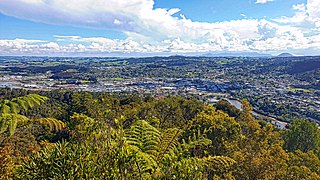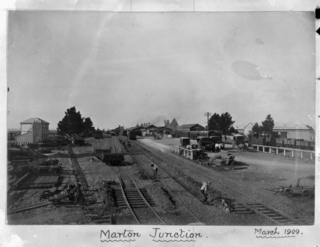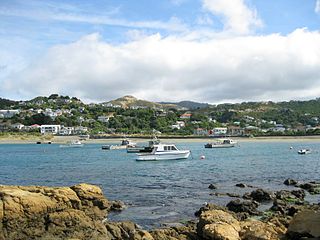Related Research Articles
The education system in New Zealand implements a three-tier model which includes primary and intermediate schools, followed by secondary schools and by tertiary education at universities and polytechnics. The academic year in New Zealand varies between institutions, but generally runs from early February until mid-December for primary schools, late January to late November or early December for secondary schools and polytechnics, and from late February until mid-November for universities.

Whangārei is the northernmost city in New Zealand and the regional capital of Northland Region. It is part of the Whangarei District, a local body created in 1989 from the former Whangārei City, Whangārei County and Hikurangi Town councils, to administer both the city proper and its hinterland. The city population was estimated to be 56,900 in June 2023, an increase from 47,000 in 2001.
Education in Scotland is provided in state schools, private schools and by individuals through homeschooling. Mandatory education in Scotland begins for children in Primary 1 (P1) at primary school and ends in Fourth Year (S4) at secondary school. Overall accountability and control of state–education in Scotland rests with the Scottish Government, and is overseen by its executive agency, Education Scotland, with additional responsibility for nursery schools being the joint responsibility of both Education Scotland and the Care Inspectorate. Scotland's private schools are overseen by the Scottish Council of Independent Schools. Children in Scotland sit mandatory National Standardised Assessments in Primary 1 (P1), Primary 4 (P4), Primary 7 (P7) at the end of primary school, and Third Year (S3) in secondary school, which assist in monitoring children's progress and providing diagnostic data information to support teachers' professional judgement.

Whakatāne is a town located in the Bay of Plenty Region in the North Island of New Zealand, 90 kilometres (56 mi) east of Tauranga and 89 kilometres (55 mi) northeast of Rotorua. The town is situated at the mouth of the Whakatāne River. The Whakatāne District is the territorial authority that encompasses the town, covering an area to the south and west of the town, excluding the enclave of Kawerau District.

Marton is a town in the Rangitikei district of the Manawatū-Whanganui region of New Zealand's North Island. It is situated 35 kilometres southeast of Whanganui and 40 kilometres northwest of Palmerston North.

Paraparaumu is a town in the south-western North Island of New Zealand. It lies on the Kāpiti Coast, 55 kilometres (34 mi) north of the nation's capital city, Wellington. It is also known to residents as Pram or Paraparam.

Island Bay is a coastal suburb of Wellington, the capital of New Zealand, situated 5 km (3.1 mi) south of the city centre.
Araura College is a college and the only secondary school on Aitutaki, in the Cook Islands. The school has an enrollment of approximately two hundred students. It was established in February 1963.

Mount Cook is an inner city suburb of New Zealand's capital city of Wellington, The North Island, New Zealand, 1.74 km dead south of Wellington's Central Business District. Its local constituency area is the Wellington Central, and is part of the City of Wellington local government area. The suburb stands on the southern fringe of the central city alongside Te Aro and to the north of Newtown.
Education in the Cook Islands has close ties with the educational system of New Zealand. Primary and secondary education are free and attendance is compulsory for children between the ages of five and fifteen. Some degree courses are provided by the University of the South Pacific.
Southern Cross Campus is a composite school that caters for students in Years 1–13 in the suburb of Māngere East in Auckland, New Zealand. The school has deep ties to the Mangere East community by providing education, facilities, and programmes for the wider use of the whole school. It is a Māori and Pacific Islands ethnic school, with students of European (Pākehā), Asian, and other ethnicities as a 0.5% minority.
Education in Kiribati is free and compulsory from age 6 to 14, which includes primary school through grade six, and Junior Secondary School for three additional grade levels. In 1998, the gross primary enrollment rate was 84.4 percent, and net primary enrollment rate was 70.7 percent. School quality and access to education are better in urban areas; schools in small communities on isolated islands are expensive to maintain. Mission schools are slowly being absorbed into the government primary school system.

Kurseong subdivision is a subdivision of the Darjeeling district in the state of West Bengal, India.
Terepai Maoate Jnr, also known as Junior Maoate, is a former Cook Islands politician. He is a member of the Democratic Party and represented the constituency of Amuri–Ureia from 2004 to 2010 and again from 2018 to 2022. He is the son of former Cook Islands Prime Minister Sir Terepai Maoate.
Teina Bishop is a Cook Islands politician, former Cabinet Minister, and leader of the One Cook Islands Movement. He was jailed for corruption in 2016.

Mirik subdivision is a subdivision of the Darjeeling district in the state of West Bengal, India. It was declared a subdivision on 30 March 2017.
Vereara Maeva-Taripo was a Cook Islander political organizer also known for her quilting of tivaevae.
References
- ↑ "Annual Report 1 July 2012–30 June 2013" (PDF). Cook Islands Ministry of Education. 2013. Retrieved 15 July 2020.